A whistleblower has sensationally claimed China deliberately spread Covid at a military tournament two months before the rest of the world knew about the deadly virus.
Ex-Chinese Communist Party insider Wei Jingsheng said The World Military Games in October 2019 could have acted as the virus’ first superspreader event.
The international tournament for military athletes was held in Wuhan – the origin of the Covid-19 pandemic – two months before China notified the World Health Organisation about its first cases.
Mr Jingsheng claimed it was no coincidence some of the 9,000 international athletes who gathered for the event reportedly became sick with a mystery illness.

Pictured: The opening ceremony of the 7th CISM Military World Games in Wuhan in October 2019. Some of the 9,000 athletes who gathered for the tournament reportedly became sick with a mystery illness two months before China told the world about its first Covid-19 cases

While China has tried to insist the virus originated elsewhere, academics, politicians and the media have contemplated the possibility it leaked from a high-level biochemical lab in Wuhan – raising suspicions that Chinese officials simply hid evidence of the early spread
‘I thought the Chinese government would take this opportunity to spread the virus during the Military Games, as many foreigners would show up there,’ he told the new Sky News documentary What Really Happened in Wuhan.
The whistleblower claimed he had heard of the Chinese government carrying out an ‘unusual exercise’ during the games.
‘[I knew] of the possibility of the Chinese government using some strange weapons, including biological weapons, because I knew they were doing experiments of that sort,’ he said.
His claims were supported by the former Principal China Adviser to the US State Department Miles Yu.
He said French, German and American athletes were among those to fall ill at the tournament with Covid-like symptoms, but were never tested for the virus.

Wei Jingsheng (pictured) claims China deliberately spread Covid at a military tournament two months before the rest of the world knew about the deadly new virus
China’s official timeline of the coronavirus pandemic vs counter-claims
Official timeline
Dec 8, 2019 – Earliest date that China has acknowledged an infection
Dec 31 – China first reported ‘pneumonia of unknown cause’ to the World Health Organisation
Jan 1, 2020 – Wuhan seafood market closed for disinfection
Jan 7 – President Xi Jinping discusses coronavirus outbreak with his politburo
Jan 9 – China makes public the genome of the coronavirus
Jan 11 – China reported its first death
Jan 13 – First case outside China is confirmed
Jan 20 – China’s National Health Commission confirms human-to-human transmission
Jan 23 – Wuhan locked down
Jan 31 – WHO declared ‘outbreak of international concern’ as China admitted having thousands of cases
Feb 23 – Italy reports cluster of cases in first major outbreak in the West
May 29 – China claims virus did not originate in wet markets but in Chinese bats before it jumped to humans via an ‘intermediary animal’
July 31 – Chinese researcher admits some coronavirus experiments conducted in lower biosafety labs
Dec 16 – WHO announces it will travel to Wuhan to probe origins of virus in January
Jan 5, 2021 – China denies entry to WHO’s investigatory team
Feb 9 – WHO dismisses theory virus leaked from lab – backs China’s claim it was imported from frozen meat
Mar 28 – Former US national security officials says intel shows ‘there was a direct order from Beijing to destroy all viral samples’ at Wuhan lab
New evidence
Sep 2019- Blood samples are taken in a lung cancer screening trial in Italy which later test positive for coronavirus
Oct – Whistleblower Wei Jingsheng claims China deliberately spread Covid at The World Military Games in Wuhan in October, two months before the rest of the world knew about the virus
Oct – Xi Jinping’s authoritarian regime tried desperately to shut down whistle-blowers like Mr Jingsheng. Any references made in social media about a new SARS virus or ‘outbreak’ were censored
Oct-Dec – Rise in ‘flu and pneumonia’ cases in northern Italy which could be linked to coronavirus
Nov – Whistleblower Mr Jingsheng claims he took his concerns about the military games to senior figures within the Trump administration but was ignored
Nov – Intelligence report passed to agencies in Washington claims three members of staff at the Wuhan Institute of Virology sought hospital treatment in November 2019 after experiencing symptoms consistent with Covid
Nov – Sewage samples taken in Florianópolis, Brazil, suggest virus was present
Nov 10 – Milanese woman has a skin biopsy, producing a sample which later shows signs of the virus
Nov 17 – Leaked documents suggest case detected in China on this date
Dec – Doctors in China, including Li Wenliang, report existance of new type of respiratory infection. But Chinese police arrested him and eight of his colleagues for questioning – instead of publicising reports and warning public
Dec 1 – Chinese researchers report an infection on this date in a peer-reviewed study, but it has not been acknowledged by Beijing
Dec 18 – Sewage samples taken in Milan and Turin suggest virus was circulating in the cities
Dec 26 – Samples analysed suggested a new type of SARS was circulating as early as December 26, but Wuhan was not locked down until January 22
Jan 2020 – Sewage samples from Barcelona suggest virus was in the city
Jan 3 – Covid-19 infections begin sweeping across other nations including the U.S. as the WHO labelled the outbreak a Public Health Emergency of International Concern
May – Scientists at a government lab in California concluded that Covid-19 may have escaped from a facility in Wuhan
July – WHO chief Tedros Adhanom Ghebreyesus said China failed share vital raw data during their investigation in Wuhan. China rebuffed those claims
August 2021: The world’s first Covid-19 patient may have been infected by a bat while working for a Wuhan lab in China, WHO chief Dr Peter Embarek said
August: A damning report by Republicans in the US claims coronavirus leaked from the Wuhan Institute of Virology, shortly after the facility tried to improve air safety and waste treatment systems
The report also cited ‘ample evidence’ that lab scientists were working to modify coronaviruses to infect humans and such manipulation could be hidden
Advertisement
‘We see some indications in our own data… that there was Covid circulating in the United States as early as early December, possibly earlier than that,’ ex-US State Department Covid-19 investigator David Asher said.
Mr Jingsheng also claims he took his concerns about the unfolding situation to senior figures within the Trump administration in November 2019 but was ignored.
The long-time democracy campaigner, who has served time in prison for ‘counter-revolutionary activities’, said he made the approach as whispers of a ‘new SARS virus’ began circulating on WeChat and other Chinese social media platforms.
‘I felt they were not as concerned as I was, so I tried my best to provide more detail and information,’ he said.
‘They may not believe that a government of a country would do something like that (cover up a virus), so I kept repeating myself in an effort … to persuade them.’
Xi Jinping’s authoritarian regime tried desperately to shut down whistle-blowers and silence any discussion of the virus in the early stages of the Wuhan outbreak – even when an untold number of corpses started flooding the city’s hospitals.
Any references made in social media about a new SARS virus or ‘outbreak’ were censored and brave medical staff who tried to speak out and warn the world were detained and forced to sign false confessions of panic-stirring.
Mr Jingsheng who was exiled to the US years earlier said he was aware of what was happening through Beijing Communist Party insiders who shared their fears about the situation and described the central government cover-up.
But despite the impending health crisis set to devastate the US and the rest of the globe, his message was not being taken seriously, he claims.
The Chinese dissident would not disclose which political leaders he spoke to but insisted they were senior government figures and had the ear of then-President Donald Trump.
‘I’m not sure if this politician wants me to talk about him right here,’ he said.
‘But I want to say he is a high enough politician, high enough to be able to reach the President of the United States.’
As coronavirus cases continued to ravage China, the authoritarian state kept the outbreak hidden from the WHO until December 31, when it was no longer possible to contain knowledge of its existence.
But even then, Beijing denied the virus could be transmitted from person to person until eventually coming clean a month at the end of January.
The WHO labelled the mysterious outbreak a Public Health Emergency of International Concern on 30 January 2020, as infections started sweeping across other nations including the US earlier that same month.
In August this year, Dr Peter Embarek, who led the WHO probe into the origins of the coronavirus pandemic in China, said the world’s first Covid-19 patient may have been infected by a bat while working for a Wuhan lab in China.
Dr Embarek made the shocking claim despite initially dismissing the notion that the virus escaped from a lab as extremely unlikely.
Embarek later admitted that the lab leak theory could have happened, suggesting that a Chinese researcher could have been infected by a bat while taking samples in connection with research at a Wuhan lab.
Some have suggested the source of the virus was the Wuhan Institute of Virology, a Chinese lab that is the world’s largest centre of research on coronaviruses.
They believe the virus was either uncovered at the lab – which collects coronaviruses from wild animals – or else engineered through ‘gain of function’ research.
Such research involves adding properties such as increased transmissibility to already-existing viruses to study the effects and develop treatments before such diseases crop up in the wild.
But the research is hugely controversial, with many scientists arguing the risks of creating such viruses far outweigh the potential benefits.
According to proponents of this theory, the virus then leaked from the lab – possibly by infecting staff who then unwittingly passed it to the general population.
One intelligence report passed to agencies in Washington claims three members of staff at the laboratory sought hospital treatment in November 2019 – a month before the first official cases of Covid were detected, the Wall Street Journal reported.
Their symptoms were ‘consistent with both Covid-19 and common seasonal illness’, the report says, calling for further investigation.
That tallies with a body of evidence suggesting Covid may have been circulating for months before China first reported it to the world – either as a result of the often-mild disease going undetected, or the result of a cover-up.
Scientists in Italy claim to have detected evidence of Covid in blood samples taken as far back as September 2019, while researchers in Spain say the disease could have been present there in January 2020 – months before the first official case.
Even the authors of the much-derided WHO report admitted they could not rule out the possibility that Covid was circulating before December 2019.
But it was not until December 31, 2019 that the WHO’s China office was informed of a mystery pneumonia which had sickened 44 people in Wuhan.
Later, the WHO was informed that at least one patient in Wuhan – a major transport hub – had been showing symptoms as early as December 8.
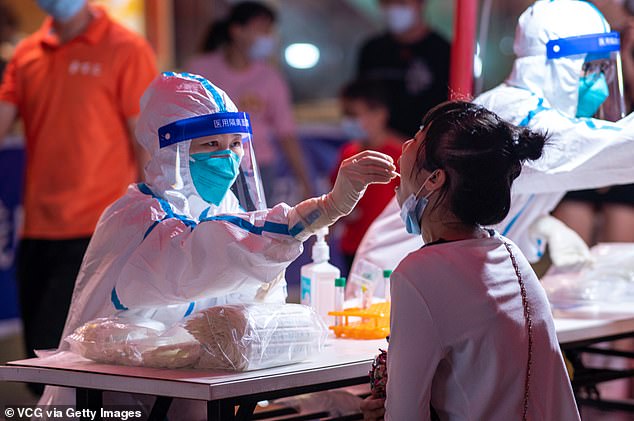
Local residents line up for nucleic acid testing at a temporary Covid-19 testing center on June 12, 2021 in Guangzhou, China


Wuhan doctor Li Wenliang (pictured, left and right) blew the whistle on the mysterious new coronavirus in December 2019 and died in February 2020 after contracting the virus from a patient
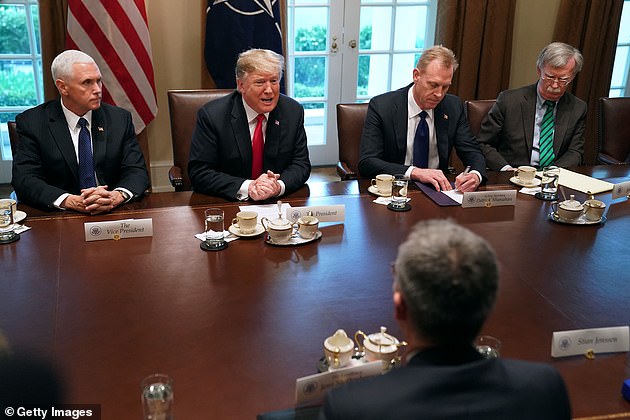
The Chinese dissident would not disclose which political leaders he spoke to but insisted they were senior government figures and had the ear of then-President Donald Trump (pictured in April)

A book by award-winning Australian Journalist Sharri Markson, with the same title as the documentary, will be released on September 29
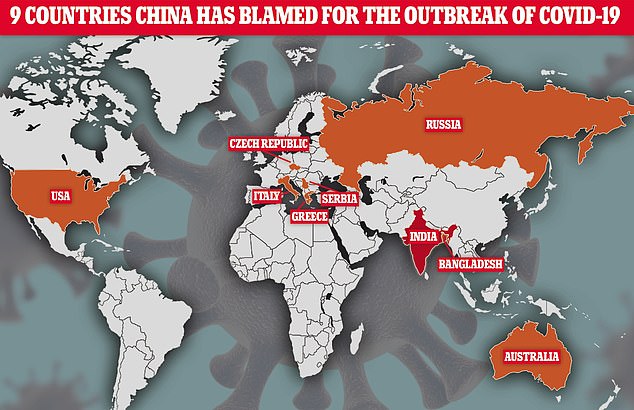
Chinese scientists and officials have been keen to point the finger of blame outside their own borders – variously suggesting that the virus could have originated in Bangladesh, the US, Greece, Australia, India, Italy, Czech Republic, Russia or Serbia

Multiple countries have uncovered evidence that the virus was circulating months earlier than originally thought. While Beijing has tried to insist this proves the virus originated elsewhere, most scientists still think China was the origin – raising the prospect that communist officials simply hid evidence of the early spread
A separate WHO-backed report said it was ‘clear’ that ‘public health measures could have been applied more forcefully by local and national health authorities in China’ last January.
It said there was ‘potential for early signs to have been acted on more rapidly’ by both China and the WHO.
The criticism was at odds with the WHO’s public statements at the time, when it praised China for the ‘remarkable speed’ with which it responded to the outbreak.
Beijing has touted its recovery from the early outbreak as a triumph for its Communist leaders, with China’s economy the only major one to grow in 2020.
But numerous reports have detailed how China withheld key details about the virus in its early stages, including from the WHO which has praised China in public.
The great cover-up of China: Beijing punished Covid whistleblower, claimed it came from US and ‘lied about death figures’
China has lied and covered up key information during virtually every stage of its coronavirus response – from the initial outbreak to the number of cases and deaths, and is still not telling the truth, observers, experts and politicians have warned.
Beijing initially tried to cover up the virus by punishing medics who discovered it, denying it could spread person-to-person and delaying a lockdown of affected regions – meaning early opportunities to control the spread were lost.
Then, once the virus began spreading, the Communist Party began censoring public information about it and spread disinformation overseas – including suggesting that US troops could have been the initial carriers.
Even now, prominent politicians have warned that infection and death totals being reported by the regime are likely to be wrong – with locals in the epicenter of Wuhan suggesting the true tolls could be ten times higher.
Initial outbreak
Doctors in China, including Li Wenliang, began reporting the existence of a new type of respiratory infection that was similar to SARS in early December last year.
But rather than publicise the reports and warn the public, Chinese police hauled Wenliang and eight of his colleagues who had been posting about the virus online in for questioning.
Wenliang, who would later die from the virus, was forced to sign a document admitting the information he published was false.
While China has been widely-praised for a draconian lockdown that helped slow the spread of the virus, evidence suggests that the country could have acted much quicker to prevent the spread.
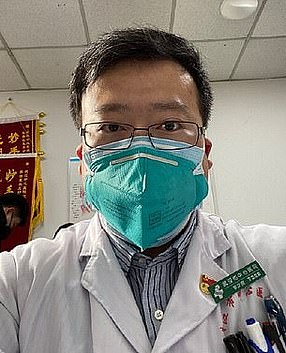
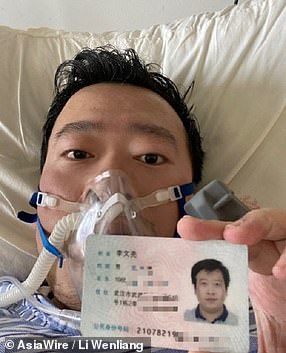
Dr Li Wenliang, one of the first Chinese medics to report the existence of the new coronavirus, was forced by police to confess to spreading false data. He later died from the virus
Samples analysed as early as December 26 suggested a new type of SARS was circulating, the Washington Post reported, but Wuhan was not locked down until January 22 – almost a month later.
Wuhan’s mayor also admitted an error that allowed 5million people to travel out of the city before the lockdown came into place without being checked for the virus, potentially helping it to spread.
Chinese authorities have also been reluctant to had over information on the country’s ‘patient zero’ – or the first person known to have contracted the virus.
While Beijing claims the first infection took place on December 8, researchers have traced the virus back to at least December 1 and anecdotal evidence suggests it was spreading in November.
A lack of information about the first patient has meant scientists are still unclear how the disease made the leap from animals into humans.
Theories include that it could have been carried by a bat or pangolin that was sold at a market in Wuhan and then eaten by someone, but this has not been confirmed.
Early reports
Chinese authorities initially reported that the virus could not spread person-to-person, despite evidence that it was spreading rapidly through the city of Wuhan including doctors being infected by patients.
This was used as justification for keeping the city of Wuhan operating as normal through a major CCP conference that was held between January 11 and 17, with authorities claiming zero new cases in this period.
China did not confirm human-to-human transmission of the virus until late January, when large parts of Hubei province including Wuhan were put into lockdown.
Despite reporting the existence of a ‘novel type of pneumonia’ to the World Health Organisation on December 31, Wuhan’s largest newspaper also made no mention of the virus until the week of January 20.
That meant people in the city were not taking precautions such as social distancing to stop it spreading.
It also meant that people had begun travelling for the Lunar New Year holiday, which was due to start on January 24 and sees millions of people visit relatives, spreading the virus further.
Furthermore, China delayed reports suggesting that some 14 per cent of patients who initially tested negative for the virus or who appeared to have recovered tested positive a second time, only confirming such cases in February.
That further hampered efforts at early containment of the virus in places such as Japan, where patients who tested negative on board the Diamond Princess cruise ship were allowed to leave – only to test positive later.
Authorities in Beijing were also slow to report the deaths of two doctors from the virus, including one who was killed on January 25 but whose death was not reported by state media until a month later.

The market was shut on January 1 after dozens of workers there had contracted the disease
Origin of the virus
Despite early admissions that the virus began in the city of Wuhan, China later back-tracked – even going so far as to suggest American troops had brought the infection over after visiting the province.
Lijian Zhao, a prominent official within the Chinese Foreign Ministry, tweeted out the claim on March 12 while providing no evidence to substantiate it.
‘When did patient zero begin in US? How many people are infected? What are the names of the hospitals,’ he wrote.

Chinese Foreign Ministry spokesman Zhao Lijian accused American military members of bringing the coronavirus to Wuhan
Referencing a military athletics tournament in Wuhan in October, which US troops attended, he wrote: ‘It might be US army who brought the epidemic to Wuhan.
‘Be transparent! Make public your data! US owe us an explanation!’
In fact, America’s ‘patient zero’ was a man who travelled from China to Washington State on January 15. The case was confirmed by the CDC six days later.
Chinese has also tried to push the theory that the virus originated in Italy, the country with the most deaths, by distorting a quote from an Italian doctor who suggested the country’s first cases could have occurred much earlier than thought.

Zhao spread the theory in a tweet, while providing no evidence to back it up
Giuseppe Remuzzi said he is investigating strange cases of pneumonia as far back as December and November, months before the virus was known to have spread.
Chinese state media widely reported his comments while also suggesting that the virus could have originated in Italy.
In fact, Remuzzi says, there can be no doubt it started in Wuhan – but may have spread out of the province and across the world earlier than thought.
Infection total
China has reported a total of some 95,000 infections from coronavirus, and at points has claimed a domestic infection rate of zero for several days in a row – even as it eased lockdown restrictions in placed like Hubei.
But, by the country’s own admission, the virus is likely still spreading – via people who have few or no symptoms.
Beijing-based outlet Caixin reported that ‘a couple to over 10 cases of covert infections of the virus are being detected’ in China every day, despite not showing up in official data.
Meanwhile foreign governments have heaped scorn on China’s infection reporting cannot be trusted.
Marco Rubio, a prominent Republican senator and former presidential candidate from the US, tweeted that ‘we have NO IDEA how many cases China really has’ after the US infection total passed Beijing’s official figure.
‘Without any doubt it’s significantly more than what they admit to,’ he added.
Meanwhile the UK government has also cast doubt on China’s reporting, with Conservative minister and former Prime Ministerial candidate Michael Gove claiming the Communist Party could not be trusted.
‘Some of the reporting from China was not clear about the scale, the nature, the infectiousness of this [virus],’ he told the BBC.
Meanwhile sources told the Mail that China’s true infection total could be anything up to 40 times as high as reports had suggested.

Marco Rubio, a prominent Republican senator, has said that China’s figures cannot be trusted and a far higher than has been reported
Death total
Doubt has also been cast on China’s reported death toll from the virus.
Locals in epicenter city Wuhan have been keeping an eye on funeral homes since lockdown restrictions were partly lifted, claiming they have been ‘working around the clock’ to dispose of bodies.

China has reported a few thousand deaths from the virus, but social media users in Wuhan have suggested the toll could be in excess of 42,000
Social media posts estimate that 3,500 urns are being handed out by crematoriums each day, while Caixin reports that one funeral home in the city placed an order for 5,000 urns.
Locals believe that efforts to dispose of the bodies began March 23 and city authorities have said the process will end on or around April 5.
That would mean roughly 42,000 urns handed out in that time frame, ten times the reported figure.
Chinese aid packages
As it brought its own coronavirus epidemic under control and as the disease spread across the rest of the world, China attempted to paint itself as a helpful neighbour by sending aid and supplies to countries most in need – such as Italy.
In fact, while the Chinese Red Cross supplied some free equipment to the Italians, the country purchased a large amount of what it received.
Meanwhile officials in Spain said that a batch of coronavirus testing kits bought from China had just 30 per cent reliability – unlike the 80 per cent they were promised.

China has said it is willing to help supply the world with much needed aid and supplies, but has been accused of hoarding protective equipment and selling test kits that don’t work
China is also the world’s largest manufacturer of disposable masks of the kind being worn to slow the spread of the virus by people while out in public.
But as the disease began gathering speed in the country in January, China began limiting exports of the masks while also buying up supplies from other countries, the New York Times reported.
As well as halting virtually all exports of masks, China also bought up some 56million masks and respirators from overseas while fears of a pandemic were still far off.
Despite reports from US mask manufacturers of factories in Shanghai being effectively nationalised, China denies it has any such policy in place and has said it is ‘willing to strengthen international cooperation’ on the issue.
Advertisement
Source link : https://www.dailymail.co.uk/news/article-10014895/Ex-Chinese-Communist-Party-insider-Wei-Jingsheng-speaks-Wuhan-theory-relating-Covid-19.html











